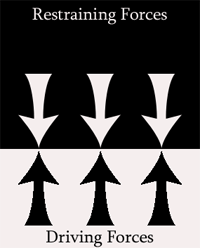 When one attempts to achieve a goal, or pursade someone, or influence an outcome, there is a human tendency to try harder and harder. The more resistance we encounter, the harder we push. This is sometimes known as the bigger hammer theory, as in “What we really need here is just a bigger hammer.”
When one attempts to achieve a goal, or pursade someone, or influence an outcome, there is a human tendency to try harder and harder. The more resistance we encounter, the harder we push. This is sometimes known as the bigger hammer theory, as in “What we really need here is just a bigger hammer.”
When we increase driving forces, it is amazing how often a countervailing restraining force pops up to neutralize our efforts. All too frequently our additional effort can have a counterproductive impact, galvanizing our opposition, providing a focus and a rallying cry.
There is an interesting Zen-like saying, “That which you attack, you risk strengthening.”
Sometimes it can be productive (and less stressful) to take a moment and think about WHY you are encountering resistance. This is sometimes called force field analysis, where you analyze the driving forces (change) and the restraining forces (status quo).
Your analysis might include an investigation of the constituants of each and their motivations, interests, and desires. Why is the opposition taking its current position? Is there any other way to satisfy their interests? Is there a ZOPA (Zone of Potential Agreement)? Is a compromise possible? A meeting in the middle? Better yet, is there a third alternative (a creative solution that actually creates value for all parties instead of a compromise, which generally is just an allocation of the existing reality)?
How can you address restraining forces? How can you satisfy, ameliorate, defuse, please, fulfill, co-opt those forces? Often just opening up a dialogue and genuinely treating the opposition’s concerns with respect will do wonders. (See Stephen R. Covey’s 5th Habit: “Seek First to Understand, Then to Be Understood.”)
In any case, taking the time to fully analyze and deeply understand the motivations behind your opposition will yield multiple rewards, not the least of which will be your expanded horizons and deepened perspective.


0 Comments